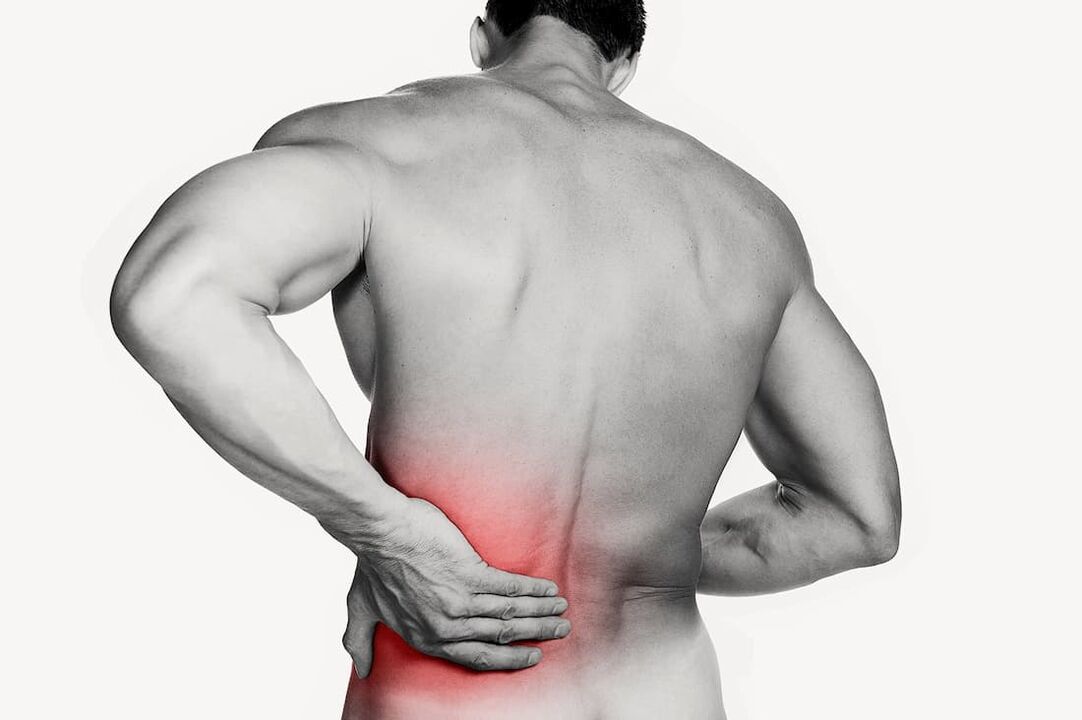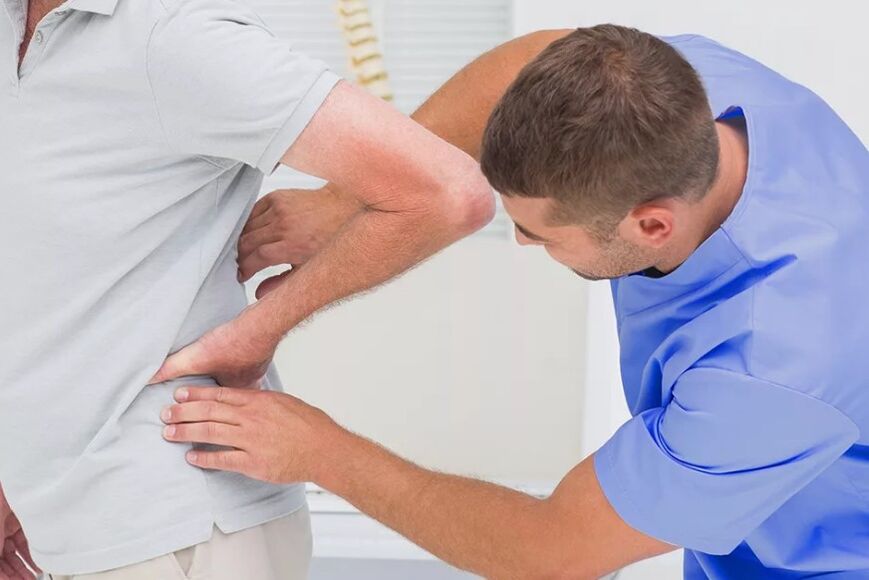
Low's pain is a symptom of little effort.Most people associate her with sitting positions, weightlifting or osteochondrosis and are not in a hurry to see a doctor.In fact, this condition can mark a disease in the kidney, liver, or intestinal tract, and problems with the musculoskeletal system will not pass by themselves.Only timely checking experts and comprehensive examinations can help determine the cause of the pain and choose the right treatment.
General information
The lower back is an area that is subjected to heavy loads due to being in an upright position.The spine is represented by five large vertebrae, which are also enhanced by a muscle frame.Of the 10 pain cases in this area, nine cases were precisely caused by the pathology of the musculoskeletal system: osteochondrosis, muscle spasms, hernia of the intervertebral disc, and nerve root clamping.
The remaining 10% of cases are associated with diseases of internal organs in lower back projections: kidney, urogenital system, intestinal tract, liver.Even doctors cannot always determine the cause of the pain during examination, which is why this condition requires a thorough laboratory and instrumental diagnosis.
Types of pain
The first thing a doctor asks is the nature of the feeling.Depending on the cause, lower back pain may be:
- Acute: Usually characterized by high intensity.The duration of feeling shall not exceed 1.5 months;
- Subacute: lasting 6-12 weeks;
- Chronic: Feeling of any intensity that lasts 12 weeks or more;
- Transfer (variable): Appears regularly;
- sore
- Dumb;
- Strong, average strength, weak.
This split is conditional.The nature and duration of the feeling may vary depending on the circumstances and circumstances.It is important to describe them as fully as possible.
reason
Causes of back injury.Most commonly, triggers help:
- Low temperature;
- weightlifting;
- uneven load distribution (in the context of pregnancy, postural disease, pathology of the musculoskeletal system);
- infectious lesions;
- Diseases of the musculoskeletal system;
- inflammatory processes, including autoimmunity;
- Stay in a uncomfortable position for a long time;
- Changes in bone tissue composition (osteoporosis);
- Volume process: benign and malignant tumors, abscesses;
- Hormonal changes (menorrhea, pregnancy, menopause);
- Kidney disease (urolithiasis, pyelonephritis, glomerulonephritis, abscess);
- Pathology of the gastrointestinal tract;
- Diseases of uterus and female appendages, male prostate, etc.
disease
Low's pain can be a symptom of various diseases of the musculoskeletal system and internal organs.The main task of a doctor is to find out what causes the disease to worsen and take the necessary measures.
This is the most common pathology.
Ankylosing spondylitis
This is a systemic inflammatory disease in which a single vertebra occurs in a single conglomerate.Meanwhile, calcium deposits in the ligament stabilize the spine, so the affected area is almost completely out of mobility.
Unique features of lower back pain with hard spondylitis include:
- Increased static intensity, especially in the case of long-term discovery of horizontal positions;
- Restrictions on movement in the waist area;
Bones and cartilage of the lumbar spine
This is a very common disease in which the intermittent disk is thinner and plays the role of a shock absorber.As a result, nerve roots and cramps in the surrounding muscles that are severely painful are stimulated.In the later stages of the disease, a hernia of the intervertebral disc is formed, which can be pressed on the spinal cord, thereby increasing pain.
As osteocartilage degeneration, the pain worsens:
- When lifted from a sitting or horizontal position;
- while trying to lie on your stomach;
- tendency.
If the disease causes a large number of hernia, pain in the lower back will usually be accompanied by numbness and weakness in one or both legs.
Curvature of the spine in the waist area (cerebrospinal, scoliosis)
This pathological pain occurs in the middle and late stages of disease development.Discomfort usually occurs at the end of the day and is usually accompanied by fatigue in the spinal muscles.Pain is usually caused by spinal muscle spasms, and it is also possible to explore the muscles when removed (muscle muscles of hips, upper and lower limbs).
Spondylitis
This is a degenerative nutritional disease of cartilage that covers the intervertebral disc.It gradually becomes thinner and destructive, and bone growth (bone plants) appears around the lesion area.Due to the reduced distance between the vertebrae, the spinal column is narrowed, and the nerve roots and spinal cord are stimulated.
The pain of this pathology:
- After loading (staying in standing position for a long time, walking) and passing after rest;
- With the stiffness of the movement, first in the morning, then constant;
- It can give the area of the thigh and hip joints.
The muscles in the lesion area are spastic and are constantly tensioned, which can also increase the pain.
Urea disease
Urolithiasis attack is characterized by severe low back pain in the affected kidneys.At the same time, the feeling will not change according to the posture, and a person cannot find at least a bit weak position.Attack is usually accompanied by a decrease in the amount of urine and changes in its color to red.
Low's pain may also be a result:
- Algorithm (menstrual pain);
- Pregnant;
- Pancreatic inflammation;
- osteomyelitis;
- intestinal obstruction;
- Appendicitis, etc.
Pain in all parts of the back
There are many reasons for the localization of pain.Pain in the upper part of the waist area may be a result:
- Spine disease;
- Injuried;
- Muscle spasms in the background of its overpressure;
- Cardiovascular disease;
- Tumor;
- Gastrointestinal diseases.
If the epicenter is at the bottom of the lower back, possible causes include spinal disorders:
- nephrology (pyelonephritis, urolithiasis);
- Intestinal destruction (constipation, flatulence);
- spasmodic or inflammatory processes of pelvic organs (Salpingoophorite, endometritis);
- Physiological reasons, especially pregnancy;
- Pinch the sciatic nerve.
Pain displacement on the right or left may indicate a lesions in the corresponding spinal column of the spinal cord kidney.
diagnosis
Diagnosing lower back pain requires a comprehensive examination.The first phase of finding the cause is investigation.The doctor clarified:
- pain positioning;
- Its character and duration;
- Causes that cause aggression or increase pain;
- The condition of improvement (certain posture, immobility, taking drugs, etc.).
Data on injury and disease have been identified without failure in chronic pathology.Further possible diagnostic searches at the discretion of the physician include:
- General examination of blood and urine: helps identify inflammatory processes in the body, renal pathology;
- Biochemical blood tests to identify signs of kidney damage, pancreas, liver, and gallbladder.
- Ultrasound of abdominal organs and pelvis, in ultrasound of prostate;
- Ultrasound of the kidneys;
- Radiography, CT or MRI of the lumbar spine;
- X-Breast.
If any pathology is suspected to be reviewed after diagnosis and examination, more targeted tests are prescribed for examination and consultation of stenosis experts.They allow you to clarify or refute the diagnosis.

treat
Treatment of lower back pain depends on its cause.Neurologists, urologists, gynecologists and surgeons can engage in pathology.If we talk about diseases of the musculoskeletal system, doctors use medical, non-pharmaceutical and surgical methods to improve the patient's condition.
Drug treatment
The most common method to eliminate low back pain is non-steroidal anti-inflammatory drugs (NSAIDS).They are in the form of tablets, intravenous and intramuscular injections, rectal suppositories, and creams, ointments and plasters for topical use.Decisions about product dosage and duration of the course are made by a doctor, as uncontrolled drugs can cause unpleasant side effects.
If NSAID is ineffective, the doctor prescribes hormonal medication (corticosteroids).They also stop the inflammatory process and help relieve pain.
The third group of drugs that improve patients' condition is anti-spastic drugs.They remove muscle cramps in the lower back.
In addition, they can be appointed:
- Reduce edema when pinching roots;
- Vitamin B improves nerve conduction;
- sedative.
Non-drug methods
Non-drug treatment supplements the medicinal regimen.Depending on the clinical situation, it may include:
- Physical therapy procedures (magnetic therapy, laser effect, electrophoresis, etc.);
- Physical Therapy Exercise: The practice process is developed separately based on the major and related diseases; gymnastics should be performed regularly not only in the office of the clinic, but also at home, only in this case it will have an effect.
- General strengthening and therapeutic massage (performed outside of deterioration);
- acupuncture;
- Manual therapy and help for bone preparation.
Surgical treatment
If one of the signs of surgical treatment is revealed based on the general situation, the surgeon's help is needed.The presence of disc hernia is not a sign of surgical treatment, regardless of its size.According to the signs, doctors can remove the hernia of the intervertebral disc, eliminate compression of the spinal cord root, remove tumors, etc.The decision to make a specific operation is made separately.
prevention
The most effective way to prevent lower back pain is to adjust your lifestyle to avoid kidneys, spine, and pelvic organs, but if pain occurs frequently, this should be a reason to raise an unusual attraction to your expert:
- Avoid hypothermia;
- Preventive exercise;
- Exercise at an amateur level (swimming is particularly beneficial to the condition of the spine and back muscles);
- Eat correctly and balancedly: prevent eating and minimize fat, spicy, oversalty foods;
- Exclude alcohol and nicotine;
- Drink at least 1.5 liters of pure water every day without considering tea, coffee or juice;
- Keep your weight index at a normal level: Excess weight does not affect the condition of the spine, and lack can lead to the nobleness of the kidneys.
If a person has diagnosed pathology of the musculoskeletal system, it is best to have a prevention course at least twice a year, according to European rehabilitation recommendations for spinal pathology, please conduct a prevention course based on the appointment of a doctor.






















